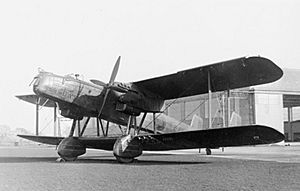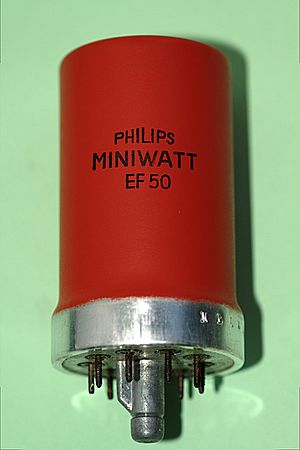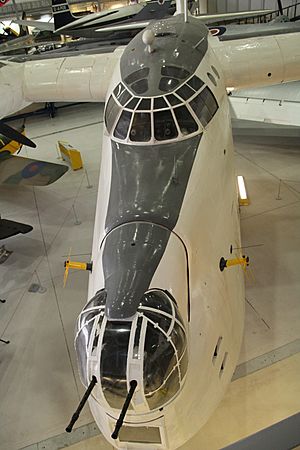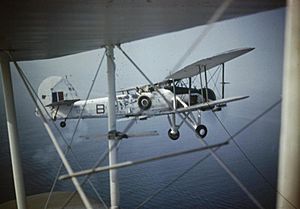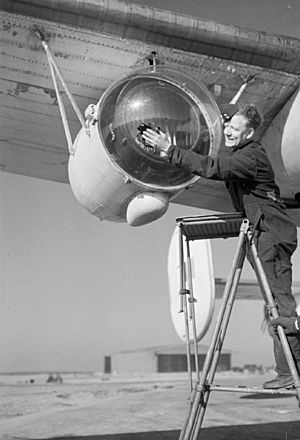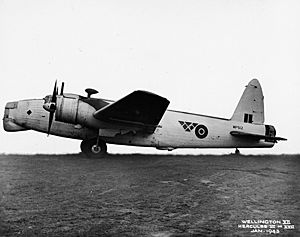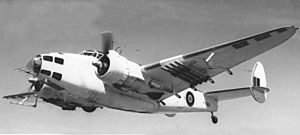ASV Mark II radar facts for kids
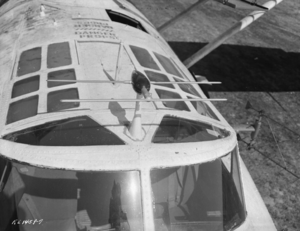
ASV Mk. II antennas on a RCAF Consolidated Canso (PBY Catalina). The transmitter is on top of the cockpit, the darker-colored port-side receiver is mounted below and to the right, angled outward.
|
|
| Country of origin | UK |
|---|---|
| Introduced | 1940 |
| No. built | ~24,600 |
| Type | Sea-surface search |
| Frequency | 176 MHz (VHF) |
| PRF | 400 pps |
| Beamwidth | ~150 degrees |
| Pulsewidth | 2.6 µs |
| Range | 1 to 40 mi (1.6–64.4 km) |
| Precision | ~5 degrees |
| Power | 7 kW |
| Other Names | Type 286, ASE (US Navy), SCR 521 (US Army) |
The Radar, Air-to-Surface Vessel, Mark II, or ASV Mk. II for short, was a special type of radar made for airplanes. It helped planes find ships and submarines on the ocean's surface. It was developed in the United Kingdom just before World War II started.
This radar was the very first one ever used on an aircraft in a real mission. It was used a lot by planes from the RAF Coastal Command, Fleet Air Arm, and similar groups in the United States and Canada. A version of this radar, called the Type 286, was also made for small ships in the Royal Navy.
The ASV Mk. II was created between late 1937 and early 1939. This happened after an experimental air-to-air radar accidentally found ships in the English Channel. The first version, ASV Mk. I, started being used in early 1940. It was quickly replaced by the much better Mk. II.
One ASV Mk. II radar was sent to the US in December 1940 during the Tizard Mission. It showed it could find large ships from 60 miles (97 km) away! Companies like Philco in the US and Research Enterprises Limited in Canada started making them right away. More than 17,000 were made for use in the US alone.
A Fairey Swordfish plane with a Mk. II radar found the German battleship Bismarck in bad weather. This led to the Bismarck being hit by torpedoes and sunk the next day. The Mk. II was not as good at finding smaller U-boats (submarines). The radar signal would get weaker as the plane got closer. This meant they could lose contact at night.
To fix this, the Leigh light was invented. This was a powerful searchlight that helped pilots see the U-boat after it disappeared from the radar. With the Leigh light, finding U-boats at night became common. This made the German ports in the Bay of Biscay very dangerous for submarines.
A newer, more advanced ASV radar was being developed from 1941. But special parts called cavity magnetrons were hard to get. Then, a British plane with a Mk. II radar was captured by the Germans. This led to the Germans creating the Metox radar detector. This device could hear the Mk. II's radar signals. Soon, British pilots noticed submarines diving away as their planes got close. A new radar, ASV Mk. III, was quickly made and started replacing the Mk. II in 1943. However, the Mk. II was still used in other parts of the war.
Contents
- How the ASV Radar Was Developed
- Early Ideas
- Accidental Discovery
- Showing What It Could Do
- Making It Better
- New Parts and Production
- ASV Mk. I in Action
- Early Use and Challenges
- ASV Mk. II: An Improved Design
- Long-Range ASV
- The Tizard Mission
- The Leigh Light
- Metox: The German Detector
- Later Versions and Replacement
- ASV Mk. III: The Microwave Radar
- How the ASV Mk. II Worked
- How Many Were Made?
How the ASV Radar Was Developed
Early Ideas
When the first British radar system, Chain Home, was being made, Henry Tizard worried about German planes attacking at night. He knew fighter pilots could only see bombers from about 1,000 yards (910 m) away. But the Chain Home radar was only accurate to about 5 miles (8.0 km).
In 1936, Tizard suggested making a smaller radar for night fighter planes. If this airborne radar could see 5 miles, Chain Home could guide the fighter close. Then the fighter's own radar could take over. "Taffy" Bowen started a team in August 1936 to work on this. They called it RDF2, which later became "Airborne Interception radar" (AI).
A big challenge was the wavelength of the radio signals. For an antenna to work well, it needs to be about the same size as the signal's wavelength. Chain Home used 10 meter wavelengths, needing 5 meter antennas. These were too big for planes. So, the team worked on systems using much shorter wavelengths, around 6.7 meters.
Accidental Discovery
In early 1937, Bowen's team got new vacuum tubes. These tubes could send out radio signals at wavelengths between 1 and 10 meters. They built a new transmitter working at 1.25 meters. This new radar was put into a Handley Page Heyford plane in March 1937.
On its first flight, the radar didn't work well for finding other planes. But the operators saw strange signals on their screen. They soon realized these signals were coming from the docks and cranes at Harwich International Port, miles away! They also saw ships, but the Heyford plane wasn't allowed to fly over water to test this properly.
Because of this accidental discovery, the team was given two Avro Anson maritime patrol planes. These planes were used to test the radar's ability to find ships. On its first real test on August 17, the Anson plane easily found ships in the English Channel from 2 to 3 miles (3.2–4.8 km) away. This was amazing, considering the radar's low power.
Showing What It Could Do
Robert Watt, who was in charge of radar research, heard about the successful test. He asked the team to do a demonstration in early September 1937. The Royal Navy and RAF Coastal Command were having military exercises in the Channel. Watt wanted to show off the new radar.
On September 3, the plane successfully found the battleship HMS Rodney, the aircraft carrier HMS Courageous, and the light cruiser HMS Southampton. The radar signals from these ships were very strong.
The next day, they flew at dawn in very cloudy weather. They found Courageous and Southampton from 5 to 6 miles (8.0–9.7 km) away. As they got closer, the Anson plane became visible through the clouds. The Courageous even launched planes to try and stop them, but it was too late. The weather was so bad that the radar was used to navigate the plane home, using signals from seaside cliffs.
Everyone who saw the demonstration was impressed. Albert Percival Rowe said, "This, had they known, was the writing on the wall for the German Submarine Service."
Making It Better
For the next year, Bowen's team worked mostly on the ASV radar. They developed new antenna systems. One experiment used a spinning antenna that showed targets as angles on one side and distance on the other. This was an early version of what is now called a B-scope display.
ASV radar was easier to develop than AI radar for several reasons:
- Big Planes: The planes used for ASV were large. This meant the radar equipment's size and weight were not as big a problem.
- Water Reflection: When radar signals hit water, they mostly reflect forward, away from the plane. This was different from signals hitting land, which scattered everywhere and caused a lot of "ground clutter" that hid targets. Water clutter was much smaller, usually only a problem within 0.5 miles (0.80 km) of the plane.
- Ship Shape: The sides of ships, rising straight up from the water, were perfect for radar. They acted like a "corner reflector". Signals hitting the ship directly bounced back. Also, signals reflecting off the water near the ship would hit the ship and bounce back too. This made ships easy to find from 10 miles (16 km) away. Cliffs by the sea also worked this way, which was great for navigation.
New Parts and Production
In May 1938, the team got new tubes that made the radar transmitter much more powerful (2,000 W). This increased the detection range for ships to 12 to 15 miles (19–24 km).
The team had trouble finding companies to build the receiver parts. Then, in early 1939, Bowen found out that Pye Electronics had built excellent receivers for an experimental TV service. These receivers used a new type of tube called the EF50 "Miniwatt," which was perfect for high-frequency signals.
This led to a big effort to start making these tubes in the UK. Ships were sent to the Netherlands to pick up Philips company leaders and thousands of EF50 tubes and parts. By July 1939, everything was ready, and an order for twenty-four radar units was placed.
ASV Mk. I in Action
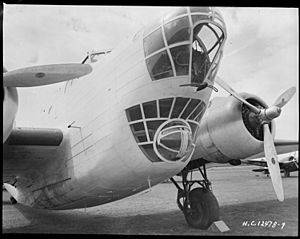
In August 1939, the Air Ministry ordered 30 AI radar units. When World War II started on September 1, many radar researchers were moved to new, often unprepared, locations. Despite this, radar sets and planes started arriving. The Fleet Air Arm also wanted ASV radars for their planes.
The first ASV radar using production parts was put into a Walrus plane. It worked at 214 MHz. Flying only 20 feet (6.1 m) above the water, the radar easily found ships. Louis Mountbatten saw this and immediately ordered one for his destroyer, HMS Kelly. The Navy then developed it as the Type 286, and 200 units were put on destroyers and torpedo boats.
By the end of 1939, 17 AI radars were fitted in Blenheim planes, and 3 ASV radars were in Lockheed Hudson planes. These numbers grew in 1940.
Early Use and Challenges
In early 1940, Hudson planes were arriving quickly. Crews could easily install the ASV Mk. I radars. The radar was also fitted to Short Sunderland and Consolidated Catalina planes. Training for the crews began.
The ASV Mk. I was the world's first operational airborne radar system. At first, crews found it hard to use for attacking submarines. It could only find surfaced submarines from about 5.5 miles (8.9 km) away. In rough seas, the minimum detection range was 4.5 miles (7.2 km), leaving little room to find them. But it was useful for staying with convoys and for navigating by seeing signals from cliffs.
The radar became much more useful after a special device called an IFF Mark II transponder was installed at the base. This device sent out a strong radio signal when it heard a pulse from an ASV radar. Crews could pick up this signal from 50 to 60 miles (80–97 km) away, making it easier to fly back to base. They called this beacon "Mother."
Reports in February 1940 showed the Mk. I was good for finding ships at night or in bad weather. But it struggled when enemy ships were close to the coast, as land signals would hide the ships. It was also good for guiding attacks when clouds were low, allowing planes to attack without being seen.
ASV Mk. II: An Improved Design
Based on what they learned from the Mk. I, Gerald Touch started designing the ASV Mk. II in January 1940. The Mk. II was mostly the same electronically as the Mk. I. But it was much better designed, with improved wiring and construction.
One key change was separating the receiver electronics from the display. This made it easier to fix problems by swapping out parts. All cables used standard connectors. This made the Mk. II much more reliable and easier to repair in the field. The only other big change was moving the operating frequency from 214 MHz to 176 MHz. This was because the Mk. I was interfering with naval radio beacons.
An order for 4,000 Mk. II units was placed. The first units arrived in the summer of 1940. By March 1941, 2,000 transmitters and 1,000 receivers had been delivered.
The Mk. II had its first success on November 30, 1940. A Whitley plane damaged U-71 in the Bay of Biscay. On May 26, 1941, a Fairey Swordfish with a Mk. II radar found the Bismarck. This led to the Bismarck's sinking the next day. By mid-1941, ASV radar increased daytime attacks on U-boats by 20%. It also made night attacks possible for the first time. The first successful night attack on a U-boat happened on December 21, 1941.
Long-Range ASV
ASV was not made to find submarines. But tests in late 1939 showed it could find surfaced submarines at a limited range in calm seas. The main problem was that the antennas didn't pick up enough signal. Since these planes flew slowly, bigger antennas could be used without slowing the plane down too much.
The team started using Yagi antennas, which were much better. These "Long-Range ASV" (LRASV) antennas became available in 1940. The transmitter was on the nose, and two receivers were under the wings, angled outwards.
Another new antenna, called a "broadside array," was developed. This antenna stretched along both sides of the plane's body. It could search wide areas of the ocean on both sides at the same time. This was a big improvement over the forward-only design. The broadside array was 2.5 times better than the original system. It could find medium-sized ships from 40 miles (64 km) away and surfaced submarines from 10 to 15 miles (16–24 km) away.
The Tizard Mission
In early 1940, the UK government debated whether to share its new technologies with the United States. The UK needed more people and factories, which the US had. They also wanted the US's advanced Norden bombsight. But British radar was considered very advanced.
Finally, Winston Churchill decided to share the technology. Henry Tizard led a team to the US. They brought four key technologies: AI Mk. IV, ASV Mk. II, IFF Mark II, and the new cavity magnetron. They could also talk about other things like the jet engine and early ideas for the nuclear bomb.
The mission first went to Canada. There, they learned that Canada was already working on an ASV radar using a shorter wavelength. In Washington, the US Navy was excited about the British cavity magnetron. This device made radar much smaller and more powerful.
This meeting helped both sides. US companies started making the British ASV and AI radars. They also began research on new radars using the magnetron. Research Enterprises Limited in Canada built a new factory to make the British ASV unit. Thousands of these units were made, mostly for the US.
The Leigh Light
Even with the ASV radar, attacking submarines at night was hard. The radar had a "minimum range" of about 1,000 yards. Closer than that, the target would disappear in the radar's own signal and water clutter. But 1,000 yards was too far to see a submarine at night, unless it was a full moon.
Humphrey de Verd Leigh, an RAF officer, came up with a solution. He designed a powerful searchlight that could be mounted on a plane. It was shaped to spread its beam over an area several degrees wide at 1,000 yards (910 m). This was about the same area as the radar beam. The light would be turned on just as the submarine disappeared from the radar screen. This would light up the target, allowing pilots to finish the attack visually.
The first Leigh lights appeared in early summer 1942. The first success was on July 5, 1942, when a Wellington plane sank U-502. After this, the ASV Mk. II and Leigh light combination became very effective. The Germans were forced to leave their bases during the day, but even then, it was dangerous.
Metox: The German Detector
In late summer 1942, British pilots reported that U-boats were disappearing from their radar as they got close. They quickly realized the Germans were using a radar detector and diving when they heard a plane approaching.
This detector was called "Metox." It was a simple system. When it received a radar pulse, it made a short sound in the radio operator's headphones. The operator could listen to the sound's strength to know if a plane was coming.
By September 1942, Metox was widely used. Studies showed that 50% of U-boats were diving before the ASV radar even saw them. Shipping losses started to rise again. Before Metox, an ASV plane found a U-boat every 95 hours of flight. After Metox, it took 135 hours.
In December 1942, British codebreakers started breaking German naval codes again. This helped find U-boats. Also, a captured British officer gave false information, saying British planes could detect Metox signals. This led to German orders to turn off Metox. This made the Mk. II effective again for a while.
Later Versions and Replacement
A more powerful version, the Mk. IIA, was made with a stronger transmitter. It had much greater range, but the sea clutter was also stronger. By this time, Metox was common, and the extra signal gave U-boats more warning. Only twelve Mk. IIA units were built.
Another solution, "Vixen," allowed the radar's signal to be quieted down. This could trick the submarine's operator into thinking the plane was flying away. Tests were successful, but by the time it was ready, the ASV Mk. III had largely taken over.
ASV Mk. III: The Microwave Radar
After the cavity magnetron was invented in 1940, all British forces started making radars using microwaves (around 10 cm wavelength). This led to ASVS (ASV "senitmetric"). Early tests in April 1941 showed they could find submarines that were partly underwater from several miles away.
Development was slow, but by January 1942, a test ASVS radar could find a small ship from 12 miles away. This led to contracts to develop it into ASV Mark III.
The ASV Mk. III started arriving in spring 1943. After some initial problems, the planes began making successful attacks. This was also when several other new anti-submarine technologies arrived. From April to July, these combined to cause huge losses for the U-boat fleet. By the end of June, cargo shipping losses from U-boat attacks dropped almost to zero.
As more Mk. III radars became available, Mk. II-equipped planes were sent to other war areas. They continued to serve until the end of the war. Some older versions with original antennas were still used in 1943, known as SRASV (Short Range ASV).
How the ASV Mk. II Worked
Differences from Mk. I
The Mk. I and Mk. II radars were similar inside. But they used different frequencies and were packaged differently. The main difference was that the Mk. I's receiver and display were in one big box. If one part broke, the whole unit had to be replaced. The Mk. I also had a pulse width of 1.5 µS and a PRF (pulses per second) of 1200 Hz.
The rest of this section is about the Mk. II.
Signals
The Mk. II radar operated at a frequency of 176 MHz. It sent out short pulses, about 2.5 µS long, 400 times every second. The radar's peak power was about 7 kW. The signals were sent through a special switch. This switch made the radar send and receive signals on one side of the plane, then the other, with each pulse.
Antennas
The original "short range" antennas were simple rods sticking out from the plane's nose. The "long range" antennas were in two sets. The transmitter was a single Yagi antenna on the nose. Two receiver Yagis were usually under the wings, angled outwards. The "broadside array" was a special antenna that ran along the sides of the plane's body. It sent signals to the side instead of forward.
Parts of the System
The complete Mk. II system had several separate boxes that were easy to remove for repairs. The main boxes were:
- The Type 3040 (T.3040) transmitter.
- The receiver.
- The Type 6 or Type 96 "indicator units," which were the radar screens (CRTs).
Two types of receivers were used. Later, a switching unit was added. This unit, called the Aerial Coupling Box Type 8, allowed a single antenna to switch between sending and receiving signals. This made it easier to install on smaller planes.
Performance
The Mk. II's performance in real missions was carefully studied. With the original SRASV antennas, it could find surfaced submarines from an average of 5.6 miles (9.0 km) away when flying at 2,000 feet. The LRASV's forward antennas improved this to 6.3 miles (10.1 km). The broadside array further increased the range to 6.9 miles (11.1 km). Flying at lower altitudes reduced the detection range but also reduced clutter from the sea.
How Many Were Made?
According to Bowen, a total of 24,600 Mk. I and Mk. II units were produced:
| Ordered | Company | Version | Total |
|---|---|---|---|
| 1939 | EKCO and Pye | Mark I | 300 |
| 1940 | EKCO and Pye | Mark II | 3000 |
| 1941 | EKCO and Pye | Mark II | 3000 |
| Research Enterprises (Canada) | Mark II | 10,000 | |
| Philco (USA) | Mark II | 7,000 | |
| PMG Research (Australia) | Mark II | 1,300 |
Some of these units were also used by the Navy as the Type 286 radar. Others were used by the Army for their Searchlight Control radars.


